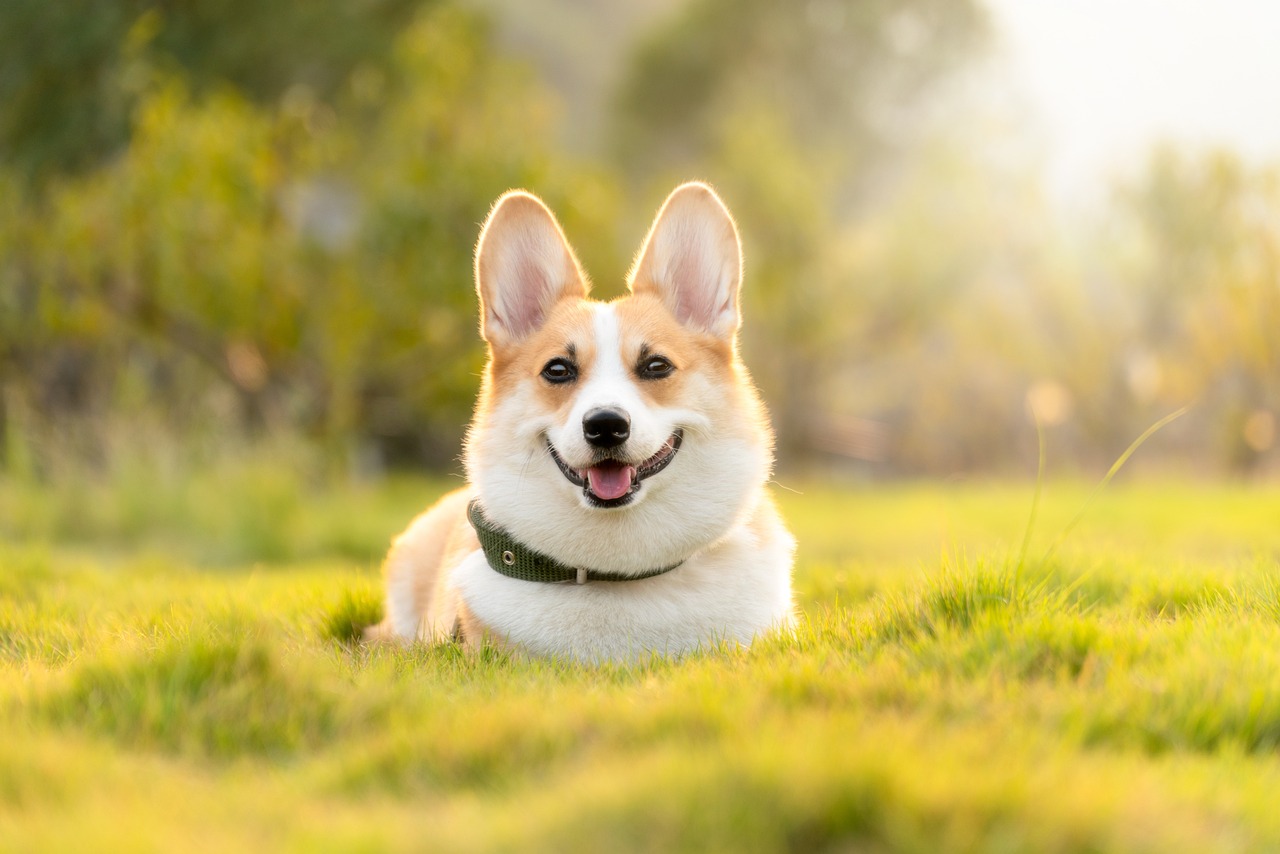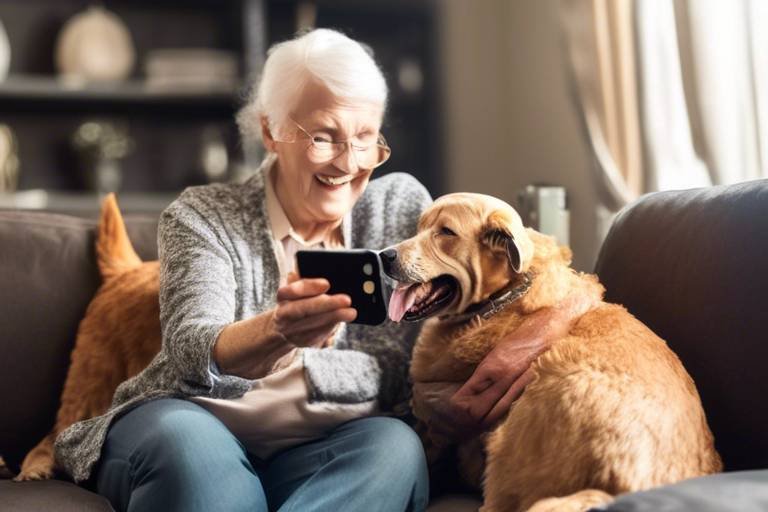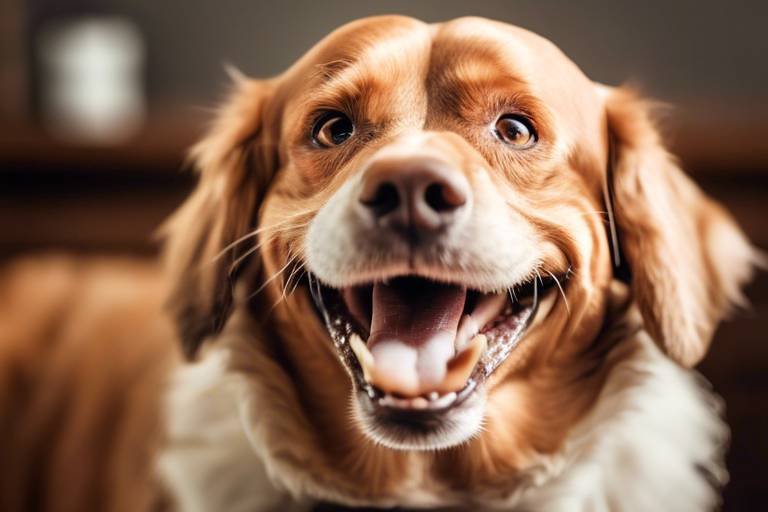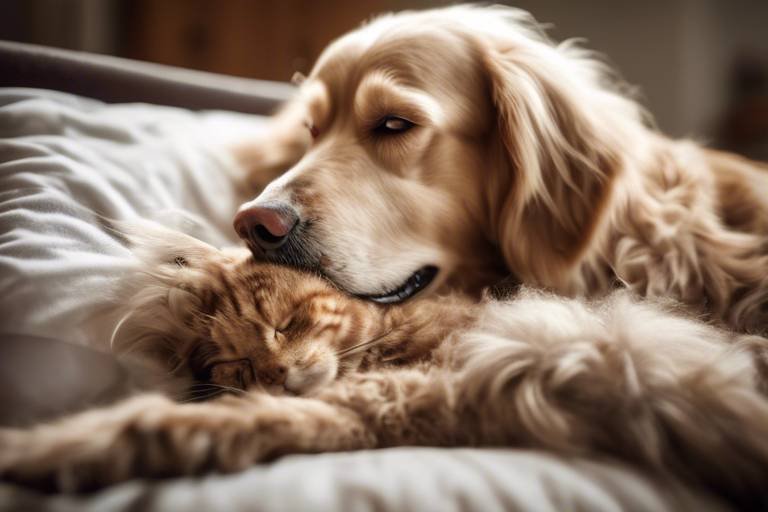The Best Ways to Socialize Senior Pets
Socializing senior pets can be a rewarding journey that not only enhances their quality of life but also strengthens the bond between pets and their owners. As our furry friends age, they often become set in their ways, which can lead to behavioral challenges and a decrease in their overall happiness. Just like us, pets thrive on social interaction, and it's essential to find effective methods to help them engage with the world around them. In this article, we will explore various strategies for socializing senior pets, ensuring they remain happy, healthy, and connected to their surroundings.
Recognizing the behavioral changes in senior pets is crucial for effective socialization. As pets age, they may exhibit new traits, such as increased anxiety or a reluctance to engage with others. Understanding these changes can help you tailor your approach to meet their needs. For instance, older pets might be less tolerant of loud noises or sudden movements, making it important to introduce them to new experiences gradually and with care. Observing their body language is key; a wagging tail or relaxed posture indicates comfort, while a tucked tail or flattened ears may signal stress. This knowledge empowers you to create a more supportive environment for your beloved companions.
Socialization offers numerous advantages for senior pets, including mental stimulation and reduced anxiety. Engaging with other animals and humans can significantly boost their mood and overall well-being. The benefits of socialization are profound and can lead to a more vibrant and fulfilling life for your pet. Here are some of the most notable advantages:
- Mental Stimulation: New experiences keep their minds sharp and active.
- Improved Physical Health: Regular interaction encourages physical activity, which is vital for maintaining a healthy weight.
- Enhanced Emotional Well-being: Positive interactions can lead to increased happiness and reduced feelings of loneliness.
Engaging with other pets and people can significantly enhance a senior pet's mental health. Just think about it: when you spend time with friends, it lifts your spirits, right? The same goes for our furry friends! Socialization combats loneliness and boredom, leading to happier, more fulfilled lives. Activities like playdates with other pets or visits to pet-friendly parks can stimulate their minds and encourage them to explore. These interactions can be as simple as a stroll around the neighborhood or as exciting as a trip to a dog park. The key is to keep things light and fun, allowing your pet to experience the joy of companionship.
Socialization can help alleviate anxiety in senior pets by exposing them to new experiences gradually. Imagine being thrust into a crowded room full of strangers; it can be overwhelming! Now, think about how much easier it would be if you were introduced to just one person at a time. This gradual exposure is essential for senior pets. Start by introducing them to one new person or pet at a time, allowing them to adjust at their own pace. Use treats and positive reinforcement to create a positive association with these new experiences. Over time, your pet will build confidence and become more comfortable in various social situations.
Rekindling a sense of playfulness in senior pets through socialization can invigorate their spirits. Just like us, older pets can sometimes lose their zest for life, but with the right encouragement, they can rediscover the joy of play. Engage them in gentle activities that stimulate both their mind and body. For example, consider introducing interactive toys that require them to think or play light games like fetch or hide-and-seek. These activities not only promote physical health but also foster a sense of joy and excitement, reminding them that life is still full of fun adventures.
Selecting appropriate socialization methods is essential for senior pets. Every pet is unique, and what works for one may not work for another. It's important to consider their individual personality, health status, and past experiences. Some pets may thrive in bustling environments, while others may prefer quieter settings. Tailor your approach by observing their reactions and adjusting accordingly. For instance, if your pet is shy, start with one-on-one interactions before gradually introducing them to larger groups. This personalized approach ensures a comfortable and enjoyable experience for your furry companions.
Creating a safe space for socializing senior pets is vital. A secure environment promotes positive interactions while minimizing stress and potential hazards. Ensure that the area is free from obstacles and distractions that could overwhelm your pet. Additionally, consider using baby gates or barriers to create designated spaces for introductions, allowing pets to observe each other from a distance before fully engaging. This gradual approach helps them feel more secure and in control of their surroundings. Remember, the goal is to make socialization a positive experience, so take your time and be patient.
When introducing new pets, a careful approach is necessary. Take your time and allow each pet to acclimate to the presence of the other. Start by allowing them to sniff each other through a barrier, such as a gate, before allowing direct contact. Monitor their body language closely; if either pet shows signs of stress, it's crucial to back off and try again later. Gradually increase their interactions as they become more comfortable with each other. This method ensures that both pets feel secure and welcomed, laying the foundation for a positive relationship.
Engaging senior pets with humans can enhance their social skills. Introducing your pet to new people should be done with care. Start with familiar faces, allowing your pet to interact with friends or family members before introducing strangers. Use treats and praise to create positive associations with new people. Encourage gentle petting and calm interactions, ensuring that your pet feels safe and secure. This approach fosters trust and comfort in social settings, helping your furry friend become more confident and well-adjusted.
Q: How can I tell if my senior pet is stressed during socialization?
A: Look for signs such as a tucked tail, flattened ears, or attempts to hide. If you notice these behaviors, it's essential to give your pet space and try again later.
Q: Is it ever too late to socialize a senior pet?
A: It's never too late! While it may take more time and patience, senior pets can still benefit from socialization and new experiences.
Q: What if my senior pet has health issues?
A: Always consult with your veterinarian before starting any new socialization activities. They can provide guidance on what is safe and appropriate for your pet's specific health needs.

Understanding Senior Pet Behavior
As our beloved pets age, their behavior can change significantly, often leaving pet owners puzzled and concerned. Understanding these changes is crucial for effective socialization. Senior pets may exhibit a variety of behavioral traits that differ from their younger counterparts. For instance, they might become less active, more cautious, or even a bit grumpy. It’s essential to recognize these shifts to cater to their emotional and physical needs.
One common trait observed in senior pets is increased anxiety. Just like humans, pets can experience anxiety, especially as their senses begin to dull. They might become startled by loud noises or unfamiliar environments, leading to withdrawal or reluctance to engage with others. Additionally, older pets may develop a preference for routine, finding comfort in familiar surroundings and activities. This can make introducing new experiences or companions a bit challenging.
Moreover, senior pets often face physical limitations that can affect their social behavior. For instance, a once playful dog may now find it difficult to keep up with younger, more energetic pets. This can lead to frustration and a desire to isolate themselves. Recognizing these limitations is vital in fostering positive interactions. Owners should be observant and patient, understanding that a senior pet's reluctance to socialize may stem from physical discomfort rather than a lack of desire to connect.
In addition to physical changes, cognitive decline can also play a role in how senior pets behave. Conditions like canine cognitive dysfunction (similar to dementia in humans) can lead to confusion and disorientation. Pets may forget familiar faces or struggle to recognize their owners, which can be distressing for both the pet and the owner. Therefore, it’s crucial to be patient and provide gentle, reassuring interactions.
To better understand senior pet behavior, consider the following key aspects:
- Changes in Activity Levels: Senior pets may not be as playful or energetic as they once were.
- Increased Sensitivity: Older pets may react more strongly to stimuli that they previously ignored.
- Social Preferences: They might prefer familiar companions over new ones.
- Health Issues: Chronic pain or illness can greatly affect their mood and behavior.
By paying close attention to these behavioral changes, pet owners can better meet their senior pets' needs. This understanding is the first step toward creating a supportive environment that encourages socialization and enhances their quality of life. Remember, every pet is unique, and their individual personality will influence how they respond to social situations. With love, patience, and a little creativity, you can help your senior pet thrive in their golden years.

Benefits of Socialization for Senior Pets
Socialization isn't just a buzzword for pet owners; it's a vital component of a senior pet's life that can dramatically enhance their overall well-being. You might be wondering, "How can interacting with others really make a difference for my older furry friend?" Well, let me tell you, the benefits are as profound as they are numerous! Senior pets, just like us, experience changes in their emotional and physical states as they age. By providing them with social opportunities, we can help them navigate these changes with grace and joy.
One of the most significant advantages of socialization for senior pets is the mental stimulation it offers. Engaging with other animals and humans can keep their minds sharp and alert. Think of it this way: just like a puzzle that needs all its pieces to be complete, a pet's mental health thrives on interaction. When they meet new friends, both furry and human, they experience a variety of stimuli that can help keep their cognitive functions active. This stimulation combats feelings of loneliness and boredom, which are common in senior pets.
Moreover, socialization can be a powerful tool in reducing anxiety. Many senior pets may develop anxiety due to changes in their environment or routine. Gradual exposure to new experiences and individuals can help ease their fears. Picture this: if you were suddenly thrown into a new city without a map, you'd likely feel overwhelmed. But if you had a friendly guide showing you around, wouldn't that make the experience less intimidating? The same applies to our pets. By slowly introducing them to new situations and companions, we can help them feel more secure and confident.
In addition to mental health benefits, socialization can also encourage playfulness. Yes, you read that right! Just because a pet is older doesn't mean they have to stop having fun. Engaging in playful activities with other pets can rekindle that youthful spirit. Imagine seeing your senior dog chasing after a ball or your cat playfully batting at a feather toy. These moments not only bring joy but also promote physical activity, which is essential for maintaining a healthy weight and preventing obesity-related issues.
To summarize, the benefits of socialization for senior pets are multifaceted. Here’s a quick recap:
- Mental Stimulation: Keeps their minds sharp and combats loneliness.
- Reduced Anxiety: Helps them feel more secure in new situations.
- Encouraged Playfulness: Rekindles their youthful spirit and promotes physical health.
Incorporating socialization into the lives of senior pets is not just beneficial; it's essential for their happiness and health. By fostering positive interactions with other animals and humans, we can create a fulfilling environment that enhances their quality of life. So, why not start planning some playdates or visits to pet-friendly parks? Your furry friend will thank you for it!
Improving Mental Health
Engaging with other pets and people can significantly enhance a senior pet's mental health. Just like humans, our furry friends experience feelings of loneliness and boredom, especially as they age. Think of your senior pet as a wise old soul who has seen it all but now craves companionship and stimulation. Socialization acts as a breath of fresh air, introducing new experiences that can rekindle their zest for life. When a senior pet interacts with others, it not only provides them with mental stimulation but also helps them feel connected to the world around them.
One of the most effective ways to improve your senior pet's mental health is through structured playdates with other animals. This doesn’t mean you have to throw a wild party; even a quiet gathering with one or two other pets can do wonders. Imagine your pet's joy when they see a familiar face, or even a new friend, ready to play! It’s like a mini-reunion that sparks joy and excitement. But remember, it's essential to monitor these interactions closely to ensure they remain positive and stress-free.
Additionally, engaging in activities that stimulate your senior pet’s mind can have profound effects. Simple games like hide-and-seek, puzzle toys, or even a leisurely stroll in a new environment can provide a fresh perspective. These activities not only keep their minds sharp but also encourage them to explore and discover, much like a child experiencing the world for the first time. Here are some activities to consider:
- Interactive Toys: Toys that require problem-solving can keep your pet mentally engaged.
- New Environments: Regularly changing walking routes can expose your pet to new sights and smells.
- Training Sessions: Short, fun training sessions can stimulate their minds and reinforce positive behaviors.
Moreover, the presence of humans plays a crucial role in a senior pet’s mental well-being. Regular interaction with family members or friends can help alleviate feelings of isolation. Consider inviting friends over or taking your pet to pet-friendly events where they can meet new people. The warmth and affection from human interactions can be incredibly comforting for senior pets, much like a warm hug on a chilly day. Remember, the goal is to create a positive environment that encourages exploration and socialization without overwhelming them.
In summary, improving your senior pet's mental health through socialization is not just about making them feel good; it's about enriching their lives in a way that promotes happiness and well-being. By incorporating regular social interactions and engaging activities into their routine, you can help your furry friend live a more fulfilled and joyful life. After all, a happy pet is a healthy pet!
1. How often should I socialize my senior pet?
It's best to socialize your senior pet regularly, but the frequency will depend on their comfort level. Start with short interactions and gradually increase the duration as they become more comfortable.
2. What signs should I look for to know if my pet is stressed during socialization?
Watch for signs such as excessive panting, whining, hiding, or aggressive behavior. If you notice these signs, it's essential to remove them from the situation and try again later in a more comfortable setting.
3. Can socialization help with my pet's anxiety?
Absolutely! Gradual exposure to new experiences and positive interactions can significantly reduce anxiety levels in senior pets by building their confidence and comfort in social settings.
4. Are there specific breeds that are more prone to socialization issues?
While all pets can benefit from socialization, some breeds may be more reserved or anxious. It's important to understand your pet's unique personality and tailor socialization efforts accordingly.
Reducing Anxiety
Socialization is not just a fun activity for senior pets; it plays a pivotal role in . As our furry friends age, they often become more sensitive to changes in their environment, which can lead to feelings of unease and fear. Think of it like this: just as we might feel anxious in unfamiliar settings or around new people, senior pets experience similar emotions. The key to alleviating this anxiety is to introduce them to new experiences gradually and in a controlled manner.
One effective strategy is to create a structured routine that includes regular socialization opportunities. This could involve short walks in familiar areas where they can meet other dogs or people they know. Over time, you can gradually introduce them to new environments. For instance, if your pet enjoys the park but is hesitant about new dogs, start with a quiet corner of the park where they can observe before interacting. This method allows them to adjust at their own pace, reducing the chances of overwhelming them.
Additionally, using positive reinforcement can be a game changer. Whenever your senior pet shows bravery in a new situation, reward them with treats or affection. This not only boosts their confidence but also helps them associate new experiences with positive outcomes. Imagine how much more comfortable you’d feel in a situation if you knew there was a reward waiting for you! It’s all about building that trust and comfort.
Another important aspect is to recognize the signs of anxiety in your senior pet. Common indicators include:
- Excessive barking or whining
- Hiding or seeking solitude
- Pacing or restlessness
- Loss of appetite
By being observant, you can tailor your socialization efforts to meet their specific needs. For instance, if your pet tends to hide when faced with new situations, consider starting with one-on-one interactions before introducing them to larger groups. The goal is to create a safe space where they feel secure and can gradually build their confidence.
In conclusion, reducing anxiety in senior pets through socialization requires patience and understanding. By taking small, manageable steps, using positive reinforcement, and being attentive to their needs, you can help your beloved companion navigate their golden years with less stress and more joy. Remember, the journey of socialization is just as important as the destination; each positive experience contributes to a happier, more confident pet.
Q: How can I tell if my senior pet is anxious?
A: Look for signs such as excessive barking, hiding, pacing, or changes in appetite. Being observant can help you identify their comfort levels.
Q: What are some good ways to socialize my senior pet?
A: Start with familiar environments, gradually introduce new experiences, and use positive reinforcement to encourage bravery.
Q: Is it ever too late to socialize a senior pet?
A: No, it’s never too late! Senior pets can still learn and adapt; just be patient and take things at their pace.
Q: How often should I socialize my senior pet?
A: Aim for regular interactions, but tailor the frequency to your pet’s comfort level. Quality over quantity is key!
Encouraging Playfulness
As our furry friends age, their energy levels and zest for life may diminish, leading to a more sedentary lifestyle. However, in senior pets is not only possible but essential for their overall well-being. Think of it as turning back the clock; just because they are older doesn’t mean they can’t enjoy life to the fullest! Engaging them in playful activities can rekindle that spark and vitality they once had. So, how do we go about it?
First and foremost, it’s crucial to understand what types of play are appropriate for senior pets. Activities that are low-impact but still engaging can work wonders. For example, consider gentle games of fetch with soft toys or interactive puzzle toys that stimulate their minds without requiring excessive physical exertion. These activities can help keep their minds sharp while also providing a sense of accomplishment. Moreover, you can introduce them to new toys that encourage curiosity and exploration. Think of it like a child discovering a new favorite game; the excitement can be contagious!
Another effective way to encourage playfulness is through social interaction with other pets. If your senior pet is comfortable, arranging playdates with younger, more energetic animals can spark interest and motivate them to engage. However, be sure to supervise these interactions closely. It’s like watching a grandparent play with their grandkids; the joy is in the connection and the shared experience. Just remember, the goal is to create a fun and safe environment where your senior pet can feel at ease while exploring their playful side.
Additionally, incorporating short, playful training sessions can be incredibly beneficial. Teaching your senior pet new tricks or reinforcing old ones can be a delightful way to bond. Use treats as motivation, and keep sessions brief—think of it as a fun class rather than a chore. This not only stimulates their mind but also strengthens your relationship. You might be surprised at how quickly they pick up on commands or even new tricks, which can instill a sense of pride and accomplishment in them.
Lastly, don’t forget about the power of routine. Establishing a regular playtime can create anticipation and excitement. Just like humans thrive on routine, pets also benefit from knowing what to expect. You could even create a play schedule that includes various activities throughout the week, ensuring a mix of mental and physical stimulation. Here’s a simple example:
| Day | Activity |
|---|---|
| Monday | Gentle fetch in the backyard |
| Wednesday | Puzzle toy challenge |
| Friday | Playdate with a younger pet |
| Sunday | Short training session with treats |
In conclusion, encouraging playfulness in senior pets is about finding the right balance between engagement and comfort. By incorporating gentle activities, social interactions, training sessions, and establishing a routine, you can bring joy and vitality back into their lives. Remember, every wag of the tail and purr of contentment is a testament to the happiness you are fostering in your beloved senior companion.
- What types of toys are best for senior pets? Soft, easy-to-handle toys and interactive puzzle toys that stimulate their mind without requiring too much physical effort are ideal.
- How often should I engage my senior pet in play? Aim for short sessions several times a week, adjusting based on your pet's energy levels and preferences.
- Can older pets learn new tricks? Absolutely! Senior pets can learn new tricks; just keep training sessions short and positive.
- Is it safe for senior pets to play with younger pets? Yes, but supervision is essential to ensure that the play remains gentle and safe for both parties.
Choosing the Right Socialization Methods
When it comes to socializing senior pets, the key is to choose methods that align with their unique personalities and comfort levels. Every pet is different, and what works for one might not work for another. It's crucial to take a step back and assess your furry friend's temperament and past experiences. For instance, if your senior pet has had limited exposure to other animals or humans, you might want to start with gentle introductions in a controlled environment. This way, you can observe their reactions and adjust your approach accordingly.
One effective method is to utilize positive reinforcement. This involves rewarding your pet with treats or praise when they exhibit calm behavior in social situations. Not only does this encourage good behavior, but it also builds their confidence over time. You might begin by inviting a calm, friendly dog over to your home for a short visit. If your pet responds well, gradually increase the duration and complexity of these interactions. Remember, patience is key!
Another technique is to create opportunities for structured playdates. This can be particularly beneficial for senior pets who may have lost their zest for play. Organizing playdates with familiar, gentle pets can rekindle their interest in social interactions. Always supervise these sessions to ensure that the play remains gentle and enjoyable for everyone involved. If your pet seems overwhelmed, don't hesitate to take a break and allow them to retreat to a safe space.
Additionally, consider enrolling your senior pet in obedience classes designed for older animals. These classes not only provide socialization opportunities but also stimulate their minds through learning new commands and tricks. It can be a fantastic way for both you and your pet to bond while meeting other pet owners. Just ensure that the class environment is accommodating and not overly chaotic, as loud noises and too many unfamiliar faces can be intimidating.
Lastly, don't overlook the power of outdoor excursions. Visiting pet-friendly parks or quiet nature trails can expose your senior pet to new sights and sounds without the pressure of direct interaction. It’s like a breath of fresh air for both of you! Just remember to keep them on a leash and monitor their energy levels, as older pets may tire more quickly than their younger counterparts.
In summary, choosing the right socialization methods for your senior pet is all about understanding their needs and preferences. By employing gentle techniques such as positive reinforcement, structured playdates, obedience classes, and outdoor excursions, you can create a rich social environment that enhances their quality of life. Always listen to your pet's cues, and don’t rush the process. After all, the goal is to foster a sense of security and happiness in their golden years.
- What are the signs that my senior pet is feeling overwhelmed during socialization? Look for signs such as hiding, excessive panting, or attempts to escape the situation. If your pet shows these signs, it’s best to give them space.
- How long should socialization sessions last for senior pets? Start with short sessions, around 10-15 minutes, and gradually increase as your pet becomes more comfortable.
- Can socializing help with my senior pet's anxiety? Yes, gradual socialization can help reduce anxiety by exposing them to new experiences in a controlled manner.

Safe Environments for Socialization
Creating a safe environment for socializing senior pets is absolutely vital. Think of it as setting the stage for a play; if the stage is unstable, the performance can falter. Senior pets, much like us, thrive in spaces where they feel secure and comfortable. To achieve this, consider the layout of your home or yard. Remove any potential hazards such as sharp objects, slippery surfaces, or anything that could cause a fall. A well-organized space not only protects your furry friend but also allows them to explore and interact freely.
Moreover, the atmosphere plays a significant role in how your pet perceives their surroundings. A calm and quiet environment can help reduce stress levels. You might want to use soft lighting and soothing sounds to create a relaxing ambiance. Incorporating familiar scents, such as their favorite blanket or toys, can also provide a sense of security. Remember, a relaxed pet is more likely to engage positively with others!
When it comes to socializing with other pets, it's essential to choose the right location. Opt for enclosed spaces such as a fenced backyard or a pet-friendly park where your senior pet can roam without the fear of running off. If you're introducing them to new pets, consider a neutral territory where neither pet feels territorial. This can significantly reduce the chances of confrontations and promote a more harmonious interaction.
It's also important to monitor the interactions closely. Look for signs of stress or discomfort in your pet, such as excessive panting, hiding, or growling. If you notice any of these behaviors, it might be time to step back and give them some space. Remember, socialization should be a positive experience, not a source of anxiety.
Lastly, don't forget to reward your senior pet during socialization sessions. Positive reinforcement can go a long way in encouraging good behavior and building confidence. Treats, praise, and affection can make all the difference in how your pet perceives social interactions.
- What are the signs that my senior pet is stressed during socialization? Look for signs such as excessive panting, hiding, or aggressive behavior. If your pet seems uncomfortable, it's best to remove them from the situation.
- How can I make my home more pet-friendly for socialization? Remove hazards, create a calm atmosphere, and ensure there are familiar items around to make your pet feel secure.
- Is it safe to introduce my senior pet to younger pets? Yes, but it should be done gradually and in a controlled environment to ensure both pets feel comfortable.
Introducing New Pets
Introducing a new pet to your home can be a thrilling yet daunting experience, especially when you have a senior pet already settled in. It's like throwing a surprise party for a friend who prefers quiet evenings at home; you want it to be fun without overwhelming them. The key is to take it slow and ensure that both the new and existing pets feel comfortable and secure throughout the process.
Start by creating a neutral territory for the initial meeting. This could be a space outside your home or a room that neither pet usually occupies. By doing this, you minimize territorial instincts that might arise. Before the introduction, allow each pet to get accustomed to the other's scent. You can do this by swapping their bedding or toys, which helps in familiarizing them with each other without direct contact.
When the time comes for the actual introduction, keep the initial meetings brief. Observe their body language closely; a wagging tail or relaxed posture indicates curiosity, while growling or hissing suggests discomfort. If either pet shows signs of stress, it’s crucial to separate them and try again later. Remember, patience is your best friend here. Just like people, not all pets warm up to each other immediately.
During these introductions, have some treats on hand. This can help create a positive association with the new pet. Offer treats to both pets when they are calm and relaxed in each other's presence. This method can be a game-changer, turning what could be a tense situation into a rewarding experience. Over time, you can gradually increase the length of their interactions until they are comfortable being around each other.
As you progress, it's essential to monitor their interactions closely. If you notice any aggressive behavior, don't hesitate to intervene. A calm, assertive presence can help guide them through their initial uncertainties. You might also want to consider using a baby gate to allow them to see each other while still maintaining a safe distance. This way, they can get used to each other without the pressure of direct contact.
Lastly, don't forget to give your senior pet plenty of attention during this transition. They might feel a bit neglected with all the excitement surrounding the new arrival. Make sure to maintain their routine and provide them with extra affection. After all, they are the ones who have been with you through thick and thin, and it’s essential to reassure them that they still hold a special place in your heart.
In summary, introducing a new pet to your senior furry friend can require a delicate balance of patience, observation, and love. By following these steps, you can create a harmonious environment where both pets can thrive together, enjoying the companionship that every pet deserves.
- How long does it take for pets to get used to each other? - It varies by individual pets, but it can take anywhere from a few days to several weeks. Patience is key!
- What signs should I look for to know if my pets are comfortable? - Look for relaxed body language, playfulness, and a willingness to be near each other without signs of stress.
- Should I supervise interactions between my pets? - Yes, especially during the initial introductions. Supervision helps prevent any aggressive behavior and ensures safety.
Socializing with Humans
Engaging senior pets with humans is not just about interaction; it's about fostering a bond that enhances their overall well-being and happiness. As our furry companions age, their social skills may diminish, making it essential to introduce them to new people in a gentle and thoughtful manner. The first step is to create a comfortable environment where your pet feels secure. This can be achieved by inviting friends or family members over who are calm and patient, allowing your pet to approach them at their own pace. Remember, forcing interactions can lead to anxiety, which we definitely want to avoid!
One effective technique is to use treats as a bridge between your pet and new people. When introducing your senior pet to a new human, have that person offer a tasty treat. This not only creates a positive association with the new individual but also encourages your pet to engage in a friendly manner. It's like throwing a little party for your pet! You can also encourage gentle petting and soft talking, which helps to build trust. The key is to remain patient; every pet has their own pace for adapting to new faces.
Moreover, consider the following strategies to enhance your senior pet's socialization with humans:
- Regular Outings: Take your pet on regular walks in the park or pet-friendly events. Exposure to different people and environments can help them adapt and feel more comfortable.
- Training Classes: Enroll in obedience or socialization classes designed specifically for older pets. These settings provide controlled environments for interactions.
- Playdates: Arrange playdates with other pet owners. This not only allows your pet to interact with humans but also with other animals, enriching their social experience.
As you work on socializing your senior pet, pay attention to their body language. Signs of discomfort may include cowering, hiding, or excessive barking. If you notice these signs, it’s important to back off and give them space. The goal is to create positive experiences, not stressful ones. Over time, with consistent and gentle exposure, your senior pet will likely become more confident and friendly towards humans.
In conclusion, socializing senior pets with humans can significantly enhance their quality of life. By creating a safe and positive environment, using treats to build associations, and being mindful of their comfort levels, you can help your furry friend thrive in social situations. Remember, patience and understanding are your best tools in this journey!
| Question | Answer |
|---|---|
| How can I tell if my senior pet is anxious around new people? | Look for signs such as hiding, excessive barking, or a tucked tail. If your pet shows these signs, it’s best to give them space. |
| What types of treats work best for socialization? | Soft, smelly treats like chicken or liver are often very appealing to pets and can encourage them to approach new people. |
| Is it too late to socialize my senior pet? | It's never too late! While it may take more time and patience, senior pets can still learn to socialize and enjoy new experiences. |
Frequently Asked Questions
- What are the best ways to socialize my senior pet?
Socializing your senior pet can be both fun and rewarding! Start by introducing them to new environments gradually, allowing them to explore at their own pace. You can also arrange playdates with gentle, friendly pets, or take them on walks where they can meet other animals and people. Remember, patience is key!
- How can I tell if my senior pet is anxious during socialization?
Look for signs of anxiety such as excessive barking, hiding, or pacing. If your pet seems uncomfortable, it’s important to give them space and not force interactions. Instead, try to create a calm environment and use positive reinforcement to encourage them when they show interest in socializing.
- Can socialization really improve my senior pet's quality of life?
Absolutely! Socialization can significantly enhance your senior pet's mental health by reducing feelings of loneliness and boredom. Engaging with other pets and people can rekindle their playful spirit and provide essential mental stimulation, leading to a happier, more fulfilled life.
- What should I consider when introducing new pets to my senior pet?
When introducing new pets, it’s crucial to do so slowly and carefully. Start with short, supervised interactions in a neutral space. Monitor their body language closely, and be ready to separate them if either pet shows signs of stress or aggression. Gradually increase their interactions as they become more comfortable with each other.
- Are there specific activities that can help socialize my senior pet?
Yes! Activities like gentle group walks, training classes, or even playdates with calm dogs can be very beneficial. Engaging in interactive games, such as fetch or hide-and-seek, can also encourage your senior pet to interact more playfully with others.
- How can I help my senior pet feel more comfortable around new people?
To help your senior pet feel at ease around new people, introduce them gradually. Allow your pet to approach new individuals at their own pace. Use treats and positive reinforcement to create positive associations with new people. Encourage gentle petting and interaction, ensuring that your pet feels safe and secure.



















